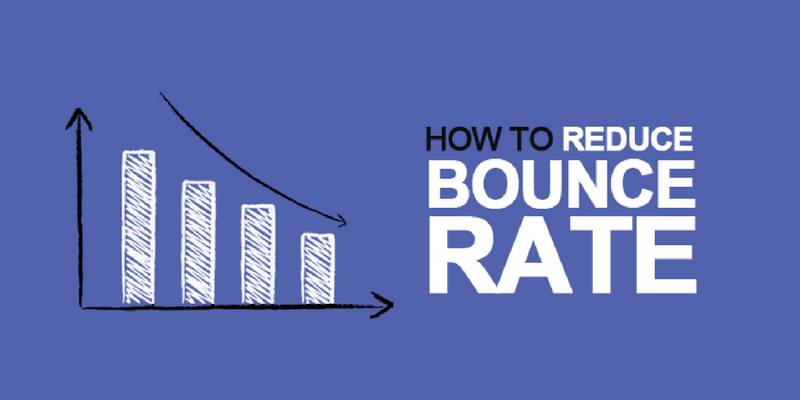The bounce rate of the website has become the most significant issue and reason for dying businesses online. Bounce rate is one of the most crucial metrics in google analytics that every marketer should pay attention to. But what is the bounce rate? Why is it so essential?

Bounce rate is a metric that shows how many percentages of visitors left a site too quickly without taking action anywhere. Perhaps the user left because he immediately found the information he was looking for, or maybe because the site seemed useless to him. And these events affect the failure rate. A large number of bounces is a negative ranking signal. Search engines lower the website on SERPs with a high bounce rate.
The results of bounce rate may vary on different search engines. Google Analytics calculates the bounce rate for the page and the overall site.
Is A High Bounce Rate Always Bad?
If your goal is to reach high on search engines, then yes, a high bounce rate is bad. A high bounce rate is the result of low-quality content on your site. It is very difficult to tell the good bounce rate, but yes, the lower, the better.
The bounce rate of a web page affects the website performance and decreases the trustworthiness of the website. Sometimes the reason behind the high bounce rate is the wrong user interface.
Websites with less responsive design are always responsible for the wrong user interface. Why I am saying, this is because users use various devices to check out your website. If users find it difficult to perceive your website, they will leave your site in between. It may result in a high bounce rate and less conversion.
Factors that are responsible for High Bounce Rate:
- The quality of the content is not good enough
- The website is not user friendly
- Slow loading site
- Title Tag and/or Meta Descriptions are missing
- Broken links or page unavailability
- Challenging to navigate on your website
- Single landing page
- Missing CTA (Call to Action)
If your website is experiencing any of these factors mentioned above, a high bounce rate is normal. But it doesn’t mean the world is finished. There are a lot of good high-quality sites that are also affected by this.
The good thing about the high bounce rate is that it encourages you towards improvement. The best way to reduce bounce is to find where the website lacks and where you need to work.
7 Tips for Reducing Your Bounce Rate
It’s time to talk about how to reduce bounce rates on your site. To improve these behavioural metrics, apply these recommendations below to reduce the bounce rate and improve the website’s ranking on search results. You can use these recommendations in combination and separately or mix the solutions that work best for you.
#1. Increase website loading speed
According to the studies, about 47% of internet users expect a page to load in 2 seconds or less. If you need to wait more than 2-3 seconds, a person is unlikely to have enough patience. Most likely, it will close the tab and go to the competitors.
You can check the page loading speed on Google Analytics. In the first case, go to the “Monitoring” section. In it, you will find a report called “Page Load Time.” It will show the average page loading time.
If you are used to using the functionality of Google Analytics, you can find the data you need in the “Behavior” section. From here, navigate to the “Page Loading Speed” section and from there to the “Overview” report. The system will show which partitions and landing ones behave worse than others.
The following measures will help to increase the website loading speed:
- Compression of pages and images.
- Application of the WebP format.
- Page caching.
- Implementation of CDN (content delivery system).
- Minify JavaScript and CSS code.
The loading speed is often slowed down by weak hosting servers, heavy design, a large number of advertisements, and errors in the program code.
#2. Check the mobile version of the site
In some niches, the percentage of users who browse the site from mobile devices or tablets exceeds the percentage of visits from a desktop browser. You can’t exactly tell from which device your users are using to browse your website, so to know that, you can refer to Google Analytics data. You will find comprehensive information here in the traffic and conversion reports.
Website owners who do not upgrade their websites to adapt to various devices often notice a high bounce rate among mobile traffic visitors.
It is important to upgrade your website if you want more visitors to land on your site. In order to do this, find out how your site looks from a tablet and google chrome browser or on your mobile devices. If you chose the chrome browser option, open the site and bring up the context menu by right-clicking on the page. Select the View Code option (Ctrl + Shift + I). An additional window will open, where at the top, you will find a device switch.
#3. Check the display of the site on different browsers
The next step, check the display of the site on different browsers, is to analyze the work of the web resources in various programs for internet surfing. To understand whether users of any of the browsers have problems, you need to use Google Analytics reports. If you find errors, hire a developer and let him fix this for you.
#4. Attract targeted traffic
The audience that is interested in your content will automatically visit your website and spend time on it. But if your content is not up to the mark, they will leave in between. To prevent this, carefully write target and fine-tuning content to attract potential customers.
When preparing content, remember that you should not post anything that goes beyond the subject of the web resource or make too tempting promises. Even if you increase the number of visitors to a site by adding pictures of any celebrity, you will not force them to read your content, and only high-quality content can do it.
Overly loud promises in the content or low quality will also lead to an increase in bounce rates. They, of course, will attract interested users, but they are unlikely to immediately leave your site if they do not find it good enough.
#5. Create content that is fun to study until the end
Adding content such as infographics, videos, animations, images helps raise users’ interest from the beginning till the end of the website. Different content formats in the website add dynamism to the content, and users feel more interested in reading the content thoughtfully. Otherwise, the person may visit your site and leave without taking any action and are unlikely ever to return.
When creating content for a website, don’t forget to add keywords and optimize if relevant to search queries. For example, if a user is searching for the best cake shop near me but ends up landing on how to make a cake at home, this will lead to an additional refusal.
It is important to write and format the content accordingly so that they always find what they are looking for.
#6. Add call to action button
What if your website is not motivating enough that it can make users take action. They will leave your site immediately and may not return again. Adding call-to-action or appealing content to the website will encourage users to take action on your site.
It will make your site more exciting and make users stay on your site for longer and may not leave it without clicking on any button. Buy Now, Checkout, Read More, Call Us are some most common call-to-action buttons that you can use on your landing page or site.
#7. Create a beautiful 404 page
Sometimes users will be taken to non-existent pages by mistake. Add good graphics, a little humour, links to the site’s main sections, or a search bar for the necessary elements on the 404 page to prevent such a session from turning into a rejection.
It may leave a good impression of your site and do not divert users from your site. Users will visit your site and recommend it to others too. It will lower bounce rates, increase user engagement and traffic on your site.
Conclusion
Bounce rate plays a role in search engine rankings as it is one of the behavioural factors. Search engines give preference to sites with the lowest bounce rate, so try to reduce it using the above methods if you’re unable to do it properly. Better trust a professional for this job.
They will provide you with a complete website audit, help optimize the whole website, reduce bounce rate and help rank your website on search engine pages. I hope you find this article interesting. Share your feedback in the comment sections below.






